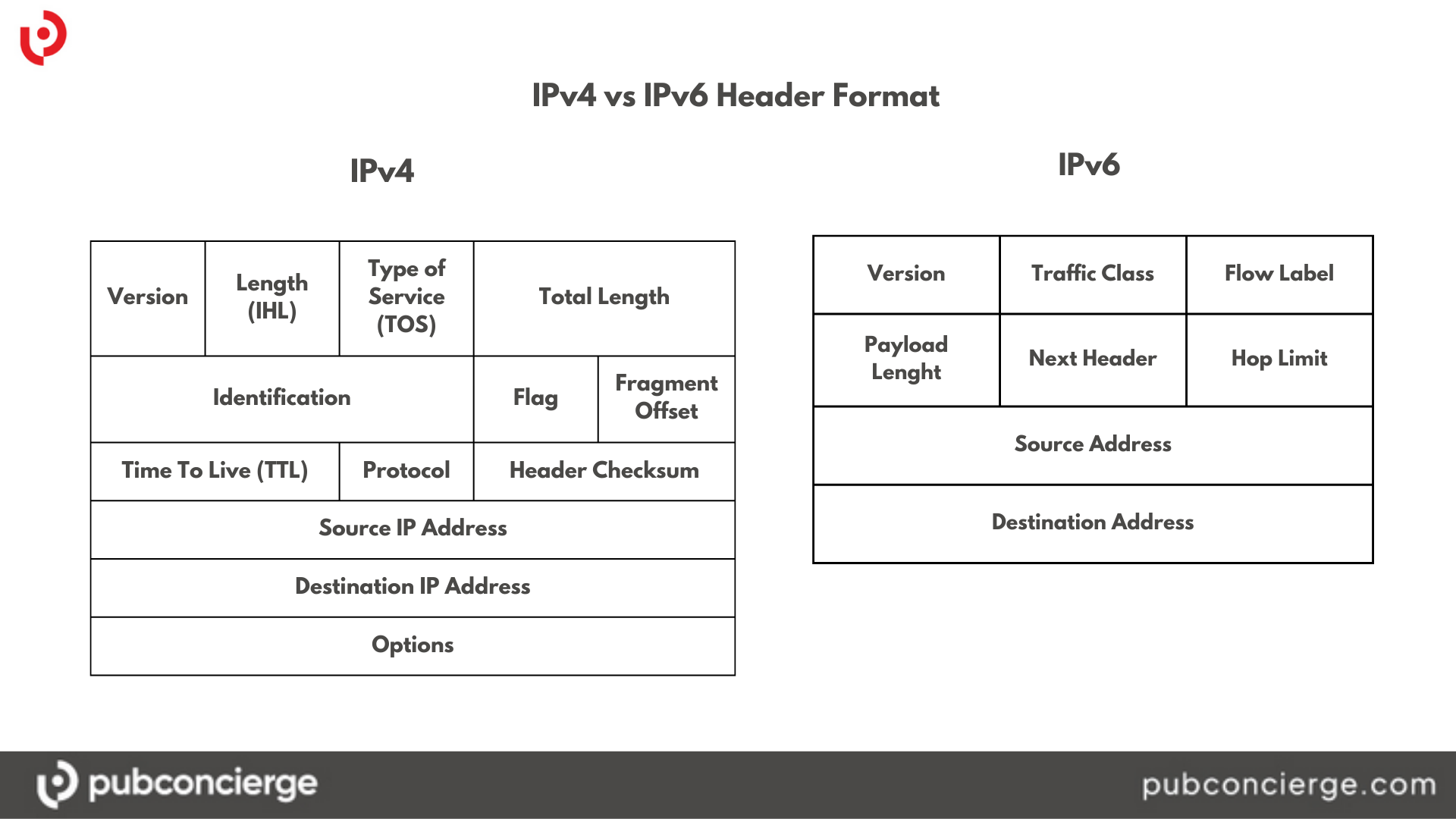IP addresses are the backbone of the online medium. You cannot connect to the Internet if your device isn’t assigned an IP address. The 1980s gave birth to IPv4, which is still widely used, despite its scarcity.
Even though time has shown us that 4 billion IPv4 addresses won’t be enough for the future of the Internet, people can’t seem to let go of the past and move to IPv6. Is it because IPv4 is better than IPv6? Not really. Is it because we’ve grown so used to the fourth version that we are hesitant to upgrade? Maybe.
However, everything has ups and downs, and so do IPv4 and IPv6 standards. So, let’s play the devil’s advocate and uncover IPv4 vsIPv6 pros and cons.
A brief overview of IPv4
The fourth version of the Internet Protocol appeared between 1982 and 1983. Its 32-bit format allows for 4,294,967,296 unique addresses to exist.
Back then, this was more than enough to support the functioning of the Internet, but that’s quite not the case anymore. There are over 5 billion Internet users nowadays. Even if IPv4 resources are running dry, the fourth version still ‘owns’ the majority of the Internet.
Most of today’s infrastructure is still based on the IPv4 standard, and things don’t seem to change too fast, or too soon. Why is that?
IPv4 Pros
Simplicity
It’s easier to use and recognize a 32-bit dotted decimal (i.e 192.87.9.23) than a hexadecimal IPv6 number (i.e 2001:0db2:83a3:0000:0000:8a2e:0370:7334).
IPv4 has 576 packet-size bytes with optional fragmentation, while IPv4 has 1208 bytes-required size without fragmentation. By fragmentation, we mean breaking down an IP datagram into smaller pieces called fragments.
Better support for topology
Network topology describes how networks fit together. IPv4 can be easily supported by most of the topology drawings. That’s because it contains simple prefixes which can easily fit inside them.
Technical support
Routing via IPv4 is really easy to handle by all systems. Almost all network operators are familiarized with IPv4 traffic. Even if all big networks might be prepared to accommodate IPv6 in their infrastructure, IPv4 is still the go-to.
VLSM (Virtual Length Subnet Mask) support
IPv4 is VLSM-friendly, meaning an address can be divided into different size subnets. The result is that a bigger network is split into more, smaller sub-networks.
These can be further split into other sub-sub-networks. This stabilizes the traffic, improves routing, and overall preserves the IPv4 lifespan.
Data Delivery
The fourth version of the Internet Protocol is designed to send data packets straight to its host as efficiently as possible. This is done thanks to the Transmission Control Protocol (TCP).
In doing so, data can be delivered directly without being duplicated. Duplicate packets are one of those things that happen in a busy network and they can sometimes be problematic.
IPv4 Cons
Configuration
With IPv4, you need a DHCP (Dynamic Host Configuration Protocol) server to assign an IP address to a device.
Configuring DHCP servers is complex and time-consuming. That’s because separate management needs to be done for its infrastructure.
Limited address space
When IPv4 was born, 4 billion seemed like a big number. But nowadays it’s not enough anymore. IPv4 availability is getting lower and lower, but methods such as NAT (Network Address Translation) help keep the numbers afloat. However, NAT is an obstacle to application development. It slows it down and it can be resource-hungry.
Geographical Restrictions
The US created IPv4. And the US owns the highest number of IPv4 addresses. Of the more than 4 billion addresses out there, 1,541,605,760 (about 35.9% of the total number) are allocated to the United States. This is far and away the highest number allocated to any country.
Mobility
IP mobility is the set of mechanisms that allow an IP mobile node to move freely between different IP networks while maintaining IP connectivity.
In other words, mobility is a protocol that lets a user move between networks without disturbing its communications. Even though IPv4 includes a specification for its mobility, it is considered inefficient.
That’s because it has its own infrastructure. As a result, its mobility nodes are quite inefficient and IPv4 has to make use of Mobile IP (MIP) and triangular routing to address the space issue for mobile devices.
An overview of IPv6
Internet Protocol version 6 (IPv6) is the most recent version of the Internet Protocol (IP). It was developed by the Internet Engineering Task Force (IETF) to deal with the long-anticipated problem of IPv4 address exhaustion.
The sixth version came with notable improvements, which would pretty much cover the needs of the modern Internet. In this respect, IPv6 pros should be tempting enough to adopt the new standard. But this remains to be seen.
IPv6 Pros
Huge address space
Because IPv6 has a 128-bit format, it provides many more unique addresses than its predecessor. IPv6 allows for 2^128, or approximately 3.4×10^38 total addresses.
To be more specific, the 128-bit format translates into 340 trillion trillion trillion IPv6 addresses.
Autoconfiguration
IPv6 benefits from SLAAC (Stateless Address Autoconfiguration ). This automates some of the network administrator’s tasks. With SLAAC, IPv6 nodes (hosts or routers) automatically configure IPv6 addresses for interfaces.
The result is that the device can get the network ID (the first 64 bits) from the router and generate its own host ID (the last 64 bits) to create a full IPv6 address.
Simple header format
The IPv6 header format is 40 bytes long and contains information essential to routing and delivery. The eight fields contain information about:
- Version;
- Traffic Class;
- Flow Label;
- Payload Length;
- Next Header;
- HOP Limit;
- Source Address;
- Destination Address.
The IPv6 header is simpler and shorter because it does not contain fields such as IHL (Internet Header Length), Identification, or Flags, which are present in the IPv4 header. Also, in an IPv6 header we do not have options, but rather extension headers.

Interoperability and mobility
IPv4 implemented a solution called Mobile IP (MIP) to solve the problem of limited addresses when it comes to mobile devices. This method makes use of triangular routing.
While this was useful for mobile devices, it also created some problems. By contrast, IPv6 uses direct routing, which lowers traffic congestion.
End-to-End Communication
IPv6 does not need NAT as IPv4 does, because of its plentiful address space. NAT is useful for tackling IPv4 scarcity, but it can slow down the process of application development.
Thus, the sixth version’s improvements allow for faster development times, and more efficient applications. On top of that, it conserves precious resources.
Multicasting
Multicasting is the process of communication between a single sender and multiple receivers on a network. This is used to send, for example, audio/video streaming broadcasts.
Using multicast, a source can send a single copy of data to a single multicast address, which is then distributed to an entire group of recipients.
For IPv6, multicasting is a base specification. The result is that IPV6 offers more efficient network operations.
IPv6 Cons
Less technical support
Network operators have yet to get fully familiar with IPv6 and handle it right. IPv4 is the most popular version worldwide, so it’s only natural the entire current infrastructure is accommodated to it.
On the other hand, IPv6 requires dedicated infrastructure and device upgrades on a large scale.
Slow adoption rate
Upgrading devices and infrastructure on such a large scale is time and resource-consuming. It will take some time to fully adapt to the new standard.
Besides, Internet Service Providers will have to disrupt the online traffic of their clients as they are preparing their infrastructure for IPv6. This can lead to frequent downtimes and inconveniences which will harm the providers’ reputation.
Even so, the adoption rate grows by 5% every year. The usage of IPv6 addresses across the world fluctuates, depending on region, provider, and users. One thing is for sure: IPv6 adoption is coming slowly but surely.
Routing Performance
Since IPv6 lacks particular routing protocol support, it relies solely on static routes. And even though it can provide some benefits (like easy configuration on small networks, or less stress on the CPU of the router), static routing does come with disadvantages as well, such as:
- Human error;
- Fault intolerance;
- Administrative distance;
- Administrative overhead.
As a result, IPv6 is less popular than IPv4.
Ties
Even if they differ in several aspects, IPv4 and IPv6 can both perform well in other fields. The sixth version might have come as an improvement designed to patch the inconsistencies of the predecessor. But that doesn’t mean IPv4 has not received any upgrades over the years.
Security
Here, IPv6 should theoretically score against IPv4. The new version fully integrates IPSec (Internet Protocol Security). This ensures IPv6 adheres to modern security architectural standards
IPv4 didn’t offer full security in its beginnings, that’s true. But over the years it has been enhanced with several updates, so the difference between IPv4 and IPv6 security is not that significant. IPSec is now available for IPv4 and it is up to network providers and users to use it or not.
Speed
Because IPv6 does not need NAT, it should offer more speed, right? Well, it does. But, slowed down by the larger packets of IPv6.
On top of that, IPv4 networks are very well optimized. In fact, they are even more optimized than IPv6 is now. So, the difference is hardly noticeable. Recent tests show that IPv4 and IPv6 perform equally well in terms of speed.
IPv4 vs IPv6 Pros and Cons – Conclusion
IPv6 still has a long road ahead. In the meantime, the IPv4 market is booming thanks to services like buying platforms and IP brokers that help businesses get the IPs they need.
This shows us that IPv4 is still in the long game. But this does not mean it does not come both with pros and cons, as we saw earlier. It’s more popular and familiar, but it has its downsides as well.
Similarly, nobody is stopping you from switching to IPv6. But you do need to keep in mind its ups and downs as well. Sure, it’s modern, and it’s pretty reliable. But are your devices compatible? Is your infrastructure ready to adopt the new standard? It’s all up to you.






